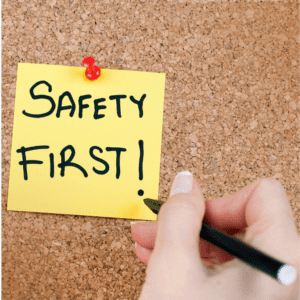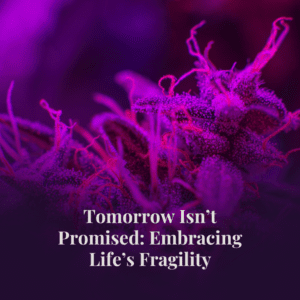Tomorrow Isn’t Promised: Embracing Life’s Fragility

In the fast-paced world we live in, it’s easy to forget how fragile life truly is. We move through our daily routines, chasing after goals and planning for the future, often assuming that tomorrow will come as expected. But life’s unpredictability reminds us that tomorrow isn’t promised. The fragility of life, though unsettling, is an essential truth that can teach us to live more fully, prioritize our well-being, and prepare for the unexpected.
While we often focus on prevention and safety measures to avoid risks and keep ourselves secure, it is just as important to have effective recovery systems in place for when life takes an unexpected turn. Understanding the delicate balance between proactive safety and the need for resilience when things go wrong is key to embracing life’s uncertainty without fear. This article explores the importance of embracing life’s fragility, the role of safety and prevention, and the need for robust recovery systems in both personal and professional contexts.
Embracing Life’s Fragility
Life’s fragility is both a humbling and powerful concept. It reminds us that every moment is precious, and nothing is guaranteed. Whether it’s a sudden accident, a health scare, or a global crisis, moments of fragility force us to reconsider our priorities and how we live our lives. We often hear the phrase “live like there’s no tomorrow,” but embracing this mindset goes beyond making rash decisions or indulging in every whim. It’s about finding balance, being mindful, and valuing the time and opportunities we have right now.
The fragility of life teaches us to:
Be present: In a world filled with distractions, embracing life’s fragility encourages us to live in the moment and appreciate what we have, whether it’s time with loved ones, nature, or even our daily routines.
Focus on what matters: When we acknowledge how quickly things can change, we naturally shift our focus to what truly matters. Relationships, health, inner peace, and meaningful pursuits become more important than fleeting material success.
Practice gratitude: The awareness that life is fragile fosters a deep sense of gratitude. Instead of taking things for granted, we learn to appreciate small joys, cherish people in our lives, and be thankful for the present.
While it’s essential to appreciate life’s fragility, it’s also important to acknowledge the tension between embracing the present and preparing for the future. This is where safety and prevention play an essential role.
The Role of Safety and Prevention
We often live with a sense of control over our lives, relying on prevention and safety measures to protect ourselves from potential harm. In personal and professional environments, safety is about minimizing risks and taking precautionary steps to prevent accidents, injuries, or disasters. Whether it’s wearing a seatbelt, creating an emergency plan, or establishing safety protocols in the workplace, prevention is essential for reducing the chances of negative outcomes.
In many ways, the desire for safety is a natural response to life’s inherent fragility. We implement systems, tools, and rules to create a sense of security and predictability, which helps us navigate life with confidence. However, safety isn’t just about preventing harm. It also encompasses our mental well-being and emotional resilience, ensuring that we feel secure enough to pursue our goals and dreams without paralyzing fear.
Prevention in Daily Life
In our personal lives, prevention can take many forms, such as:
Health precautions: Eating well, exercising, attending regular checkups, and practicing self-care to avoid illness.
Financial security: Saving for emergencies, having insurance, and budgeting responsibly to prepare for unexpected financial challenges.
Emotional safety: Setting boundaries, cultivating positive relationships, and seeking help when needed to maintain mental health and emotional stability.
Prevention in the Workplace
In professional settings, safety protocols are vital for creating a secure environment where people can work without unnecessary risk. Occupational safety involves policies, training, and tools that help reduce the likelihood of accidents and injuries. Industries like construction, healthcare, and manufacturing are particularly prone to hazards, but safety measures are essential across all fields.
Zero injury objectives are a common goal in many workplaces, aiming for accident-free environments. These objectives emphasize prevention through risk assessment, employee education, and continuous monitoring of potential dangers. While striving for zero injuries is admirable and necessary, it’s important to acknowledge that absolute safety is not always achievable. Despite our best efforts, accidents still happen, and systems must be in place to deal with those situations when they arise.
The Need for Recovery Systems
No matter how well we plan and prepare, life is full of uncertainties. This is why, in addition to safety measures, we must also have effective recovery systems. Whether in our personal lives or professional spaces, having recovery systems in place allows us to bounce back from adversity, learn from setbacks, and rebuild.
In both emotional and practical terms, recovery systems are about resilience. It’s the ability to adapt to challenges, overcome difficulties, and come out stronger on the other side. When we view recovery as an essential part of safety, we shift from a mindset of avoiding all risks to one of embracing uncertainty with the tools to manage it effectively.
Personal Recovery Systems
Life’s fragility often becomes most apparent when we face personal hardships, such as the loss of a loved one, a health crisis, or an unexpected career change. In these moments, personal recovery systems become critical for navigating difficult times.
Emotional resilience: Developing emotional resilience involves cultivating a mindset that allows us to cope with stress and recover from traumatic events. Practices like mindfulness, therapy, meditation, and community support are key elements of building resilience.
Financial recovery: Having a financial buffer, such as emergency savings or insurance, helps individuals recover from economic setbacks. Financial security gives people the ability to face unexpected challenges without being overwhelmed.
Physical recovery: After a medical issue or injury, physical recovery plans like rehabilitation, proper nutrition, and mental health support can speed up healing and get people back to their everyday lives.
Workplace Recovery Systems
In the workplace, recovery systems are equally important. When an accident or error occurs, companies need to have the right procedures in place to mitigate damage, learn from mistakes, and improve operations moving forward.
Post-incident investigation: After a workplace accident, a thorough investigation should take place to understand what went wrong and how similar incidents can be prevented in the future.
Emergency response plans: Companies should have clear, practiced procedures for responding to emergencies, whether it’s a fire, injury, or other crisis. These plans need to include first aid, evacuation protocols, and communication strategies.
Employee support: Offering employees counseling, medical support, and time off after an accident or traumatic event is critical to their recovery. Businesses that prioritize their workers’ mental and physical well-being during times of crisis build loyalty and foster a culture of care.
Embracing Life’s Uncertainty
Ultimately, life’s fragility is an inescapable reality. We cannot predict every outcome or prevent every misstep, but we can take steps to prepare and build systems that allow us to recover when challenges arise. By embracing life’s fragility and understanding the value of both prevention and recovery, we position ourselves to navigate life’s uncertainties with resilience, gratitude, and clarity.
We need to accept that safety isn’t just about preventing harm—it’s also about having the ability to recover when things don’t go according to plan. In this way, we can live more fully, knowing that while tomorrow isn’t promised, we are equipped to handle whatever it brings.











